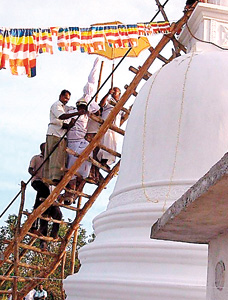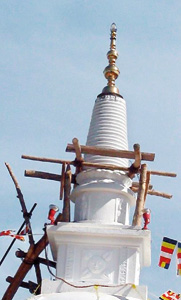Ver revistas online bravo …… The villagers in remote Hulannuge close to Lahugala (famous for elephants roaming around at any time of the day) on the Moneragala-Pottuvil (-Arugam Bay) Road, were gathered for a rare pinkama. They were to participate in a pinnacle-laying ceremony of the newly-constructed chaitya……
The remote village of Hulannuge turns into a hive of activity as villagers prepare for a rare pinkama, says D.C. Ranatunga who was present
As dusk fell they made their way to the village temple in their numbers. A festive mood prevailed. Little ones were attracted to the balloon sellers. The women were taking a close look at the posters on Buddhist themes. The men pulled out their wallets and parted with a few rupees for the cash collection. The names were announced over the sound system and merit offered. A ‘viridu’ singer with a ‘rabana’ in his hand recited verses fit for the occasion.
The villagers in remote Hulannuge close to Lahugala (famous for elephants roaming around at any time of the day) on the Moneragala-Pottuvil Road, were gathered for a rare pinkama. They were to participate in a pinnacle-laying ceremony of the newly-constructed chaitya.
In the rocky terrain, the hilltop was an ideal site for the chaitya which could be spotted from a distance. It was years of hard labour. Transporting bricks, cement, sand and other building materials was no easy task. It was the shramadana effort of the illagers, the generosity of a few businessmen and well-wishers and above all the determination of Kurundugolle Saarananda Thera that saw the project through.
As we reached the chaitya site the day before the ceremony, men and women of all ages were busy putting the finishing touches. A bevy of girls was painting the four mal aasana a?? the enclosures for offering flowers. “We are the teachers of the daham pasela,” they said. Young men were painting the chaitya. They were from the Special Task Force (STF). For many moons they had been guarding the temple and the village. It was dangerous territory not so long ago, with the Liberation Tigers of Tamil Eelam (LTTE) terrorising the villagers. The villagers used to spend the nights in the temple, with the STF providing security 24 hours of the day. Even with the dawn of peace, they continue to be in the temple.
Right at the top of the chaitya, two masons were preparing the base for the kotha (pinnacle) to be fixed. We looked around to see how the pinnacle would be brought up. There were no cranes which are seen in urban areas for this sort of ceremony. A sturdy ladder using heavy wooden trunks had been fixed using thick ropes. They were confident it could take the load of the party who were to accompany the kotha to the top.
Having spent the night at the only guest house in the nearby town of Siyabalanduwa, we were at the temple early on the day of the pinkama. The painting of the chaitya was still going on. The site was being cleared to erect a mandapaya for the all-night pirith ceremony. The rest of the area around the chaitya was being hurriedly levelled for the people to sit and listen to pirith.
Down below in the dana shalawa a few men were constructing the pirith mandapaya using gokkola. How would the mandapaya be carried to the top, we wondered. They were doing it in sections to be taken up and assembled. It was fascinating to watch the artistic hands at work weaving the simple but attractive gokkola designs. They were obviously clever artists who knew this traditional craft.
Towards evening, the finishing touches were being given to the chaitya. The compound was gaily decorated with Buddhist flags. Rows of jet bulbs were hanging from the top of the chaitya glittering in the fading light. Two spotlights were fixed at the base where the pinnacle was to be placed. The pirith mandapaya was set up in a special enclosure and decorated with na leaves, flowers and other traditional items meant for the occasion. Chairs were laid for 20 monks and covered with white cloth as is customary. The pirith pan kale a?? the pot of water — flowers and bundles of pirith nool were on the table.
Giving sufficient time for the village people to wind up their home chores and get to the temple for the night, the maha pirith was scheduled for around 9 p.m. Closer to the appointed hour they flocked to the hilltop, spread their mats and took up their positions to spend the night. Accompanied by drummers, the pirith potha , the relics and the kotha were brought in procession and placed in the mandapaya. The monks followed.
A cool breeze made it a comfortable evening and was a welcome change from the hot weather experienced throughout the day. After the maha pirith, the rest of the suttas was to end before 3.47 in the morning a?? the auspicious time for the enshrinement of the relics. With drums beating and jasmine flowers being spread over the relic casket, the relics were taken up and enshrined in the square enclosure just below where the pinnacle was to be placed.
Everyone eagerly awaited the koth pelendaveema. Amidst cries of sadhu, sadhu the pinnacle was carefully carried to the top of the chaitya and placed at the auspicious time of 5.57 in the morning. It was covered with a white cloth.
The devotees then started crowding round the pirith mandapaya to get the pirith nool. While one podi hamuduruwo was kept busy giving away the thread, another distributed pirith water.
It was now time for the preparation of the kiri pindu dana a?? a special milk rice dish — to be offered at the newly built mal aasana once Buddha statues were placed in them. The placement of the statues coincided with the opening of the pinnacle.
An unforgettable experience for the folk in Hulannuge was slowly coming to an end.
source:


 Arugam Forum
Arugam Forum Arugam Photo Galleries on Picasa
Arugam Photo Galleries on Picasa Old Website
Old Website Press Coverage
Press Coverage Surf Forecast for Arugam Bay
Surf Forecast for Arugam Bay
0 Responses to “To the cries of sadhu, sadhu a pinnacle is placed”